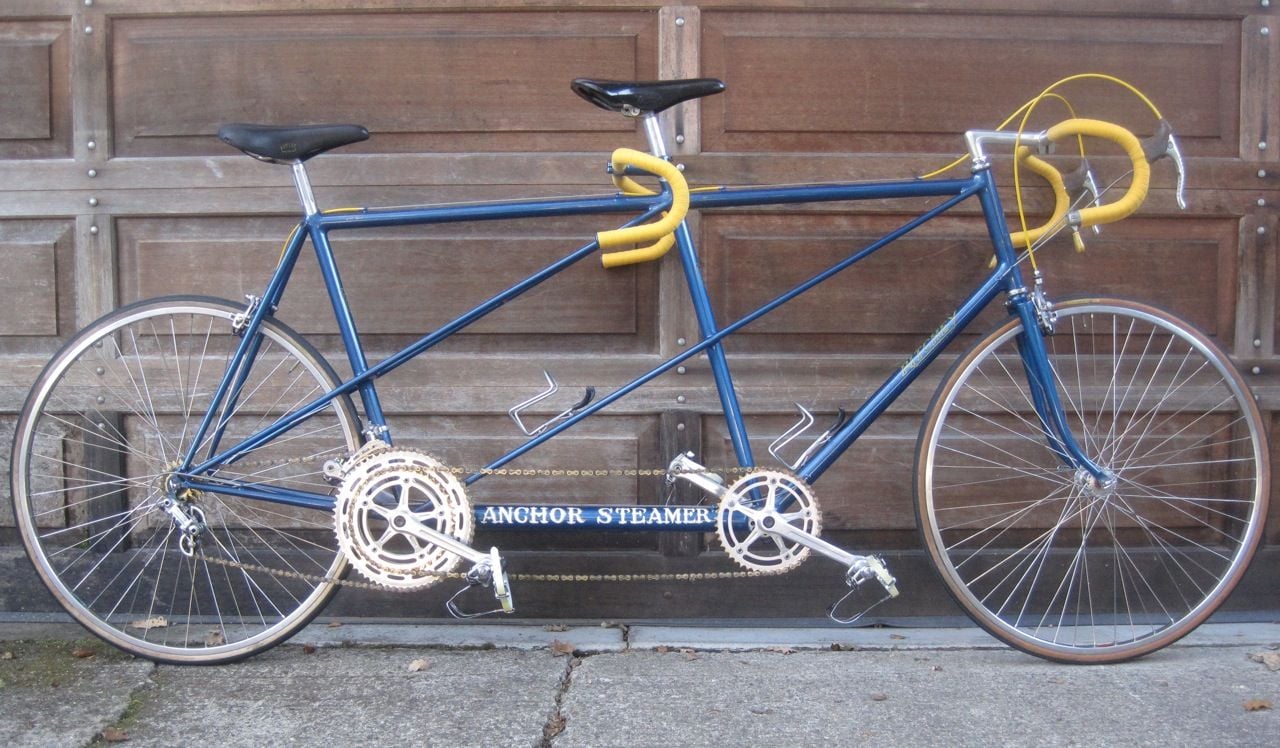Originally Posted by
Markeologist
Thanks for the reply and sorry to hear about the mishap. The bike I bought is the one from the Bicycle Museum, it used to hang above the door (pic is from museum courtesy of Icepick Trotsky). Otis Guy and Joe Breeze's Ritchey was dark blue and decaled with "ANCHOR STEAMER" as they had sponsorship from Anchor Steam/Fritz Maytag for their cross country record attempt. Their Ritchey is currently in the US Cycling Museum in Davis. It was for sale for a bit in Marin but I passed as it was way too big for me...but I loved the history. I've wanted an early Ritchey road tandem since seeing the Anchor Steamer and pounced when this one came up for sale in my size. I asked about your components as I think mine received a few changes over the years...not many but a few. Thanks again, stay healthy, and I wish your wife a solid recovery. Mark


My memory was wrong about the color of JOE Breeze's and Guy Otis' tandem.
So you also have one of those original Ritchey tandems. It is by far the best tandem frame we ever rode - both stiff and light with that smooth ride that comes from steel tubing. It also fits Jean and me perfectly. Most tandem frame builders in the 70s subscribed to the silly myth that tandems climbed slowly because of their long wheel bases. Bob Jackson and Schwinn actually built their tandems with a curved rear seat tubes so that the rear wheel could be moved forward. This was all nonsense and usually resulted in a cramped fit for the stoker. Tom toyed with the same myth when he built his very first tandem. However, not wanting to short change the stoker (he had just married his first wife) he reduced the wheelbase length by shortened the front top tube and then added an extra long stem. We test rode that bike, liked the workmanship but talked Tom into a more conventional geometry for our bike. I believe our tandem was the first he made of this series.
Your frame has several differences from ours. The most notable are the brakes. We rode with Campy side-pulls and yours has Mafac cantilevers. If you measure the mechanical advantage, they are the same for both brake designs. We opted for the side-pulls because of we had damaged the cantilever brakes we had on our previous tandem (one of those Bob Jacksons with a silly curved seat tube). Also, the Campy side-pulls are a little stiffer. Do you also have a hub brake?
Another difference is the connection between the rear diagonals and the rear seat tube. In our bike that connection is a single tube that runs through the seat tube, perpendicular to the plane of the frame. It looks like your frame has the more elegant X connector, which is made up of two tubes that cross at the center axis of the seat tube. Tom developed that design for the prototype with the short base I mentioned earlier. However, we were pressing him for time (after all summer was coming) so to save time he built our frame with the simpler design.
Our forks are very different; however, ours is not the original fork Tom built for us. Currently our frame has its fifth fork. Tom built the first fork with an open crown and reinforced blades. It looked like the fork shown in the photo attached to my earlier message. That fork had a very strong crown and blades, but Tom used a standard size steerer, which made us very nervous because the likely point of failure was hidden behind the bottom headset race. Therefore, after a year, just to stop us from complaining (and because he is a nice guy) Tom made a new fork for us based on what is called a "Masi crown". This fork actually failed on us because of a bad braze so Tom made a third fork that was the prototype for the unicrown design that became his standard design for the bikes he built in the 80s. As prototypes tend to do, that unicrown fork eventually failed. Unfortunately Tom was out of town and we were headed off to Europe so another frame building friend (Peter Johnson) built a replacement, based on the original open crown design. Unfortunately, that fourth fork eventually failed where the fork blade was brazed to the underside of the upper crown plate. Peter solved that problem, leaving us with the current fork we have ridden for roughly 20 years.
By the way, when a say a fork "failed", I mean a crack formed. If any of these forks had actually broken, in the usual sense, I probably wouldn't be writing this message. The advantage of steel frames is that the cracks that form as the first stage of a failure make a lot of noise. We also painted our frame a bright color so that cracks would be more visible.
We had Tom setup our bike with the connecting chain on the right side to avoid the risk of breaking the rear spindle. As I mentioned earlier, we had seen that happen. Also, a same-side drive has a stiffer feel because the front rider doesn't wind up the rear spindle when stomping up a hill. We also liked having conventional parts on our bike. Stripping a thread on any one of those beautiful Campy tandem cranks leaves you with the expense of replacing the entire crankset. Eventually we did break the rear crank on the right side. The failure was on one of the five spiders. However, single right-side cranks are easy to come by.
We replaced our Campagnolo pedals with Shimano SPDs when clipless pedals came along. Also our rims have gone through countless replacements over the years. Otherwise, our Ritchey is pretty much the way it was when we first put it together back in the Spring of 1977.